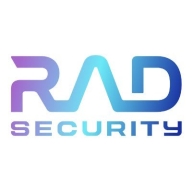

Find out what your peers are saying about Microsoft, CrowdStrike, SentinelOne and others in Identity Threat Detection and Response (ITDR).
| Product | Market Share (%) |
|---|---|
| SentinelOne Singularity Identity | 4.8% |
| RAD Security | 0.1% |
| Other | 95.1% |

| Company Size | Count |
|---|---|
| Small Business | 4 |
| Midsize Enterprise | 5 |
| Large Enterprise | 13 |
RAD Security offers integrated cybersecurity solutions designed to protect infrastructures from threats. It provides dynamic threat detection and comprehensive protection mechanisms for businesses. Tailored for organizations prioritizing robust security measures and scalable implementations.
RAD Security delivers advanced capabilities to safeguard business environments. Its architecture enables real-time threat analysis, delivering prompt alerts and countermeasures against emerging threats. Aimed at enterprises, it supports diverse IT ecosystems and prioritizes effective risk management strategies. RAD Security consistently updates its tools to respond to the latest cyber risks, ensuring users can rely on dependable threat mitigation. Its innovative features empower users to set up defenses quickly, adapting to security needs.
What are the standout features of RAD Security?In industries such as finance and healthcare, RAD Security's implementation involves deploying tailored configurations maximizing detection and response benefits. These sectors often require stringent data protection and benefit from RAD Security's scalable protection methods and automated reporting tools. Users implement these solutions to align with industry standards and enhance data privacy safeguards.
Singularity Identity, a component of the Singularity platform, provides threat detection & response (ITDR) capabilities to defend Active Directory and domain-joined endpoints in real-time from adversaries aiming to gain persistent, elevated privilege and move covertly. Singularity Identity provides actionable, high-fidelity insight as attacks emerge from managed and unmanaged devices. It detects identity misuse and reconnaissance activity happening within endpoint processes targeting critical domain servers, service accounts, local credentials, local data, network data, and cloud data. On-agent cloaking and deception techniques slow the adversary down while providing situational awareness and halting adversarial attempts at lateral movement. Singularity Identity helps you detect and respond to identity-based attacks, providing early warning while misdirecting them away from production assets.
Singularity Identity’s primary use case is to protect credential data and disrupt identity-based attacks. The most valuable function of Singularity Identity is its ability to misdirect attackers by providing deceptive data to identity-based recon attacks. Additionally, it can hide and deny access to locally stored credentials or identity data on Active Directory domain controllers.
Singularity Identity also provides rapid detection and respond to identity attacks, capturing attack activity and feeding it directly to the Singularity platform’s Security DataLake for enterprise-wide analysis and response.
By implementing Singularity Identity, organizations benefit from enhanced security, reduced credential-related risks, and improved user productivity. It detects and responds to identity-based attacks, ensuring only authorized individuals can access critical identity data. With its cloaking capabilities to hide identity stored locally on endpoints or in the identity infrastructure and it’s ability to provide decoy results to identity-based attacks, organizations can effectively secure their sensitive or privileged identities, resulting in improved overall identity security.
We monitor all Identity Threat Detection and Response (ITDR) reviews to prevent fraudulent reviews and keep review quality high. We do not post reviews by company employees or direct competitors. We validate each review for authenticity via cross-reference with LinkedIn, and personal follow-up with the reviewer when necessary.